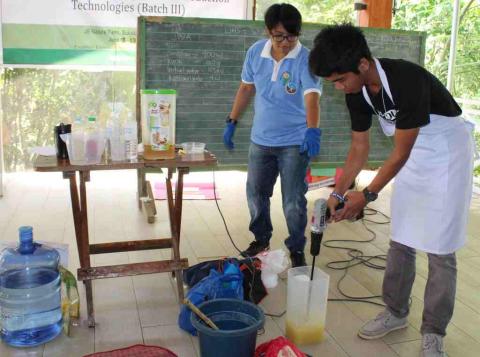Ms. Jhoanna Garcia (left) discussed the Jadam Technology and performed two of its concoctions: Jadam Sulfur and Jadam Wetting Agent, during the Training on Organic Agriculture Production Technologies on June 11-13, 2019 in Surigao City.
SUKAILANG, Surigao City – There were 31 participants comprise of Agricultural Extension Workers (AEWs) and farmers from the Province of Dinagat Islands and Surigao del Norte who joined the Training on Organic Agriculture (OA) Production Technologies Batch 3 where JADAM, a low cost and environment-friendly Korean technology was introduced.
Ms. Jhoanna Garcia, the owner of JABEZ farm and consultant of Nature Farming Technology System (NFTS), explained the origin and history of Jadam. Said technology was first practiced by Young Sang Cho who was identified as its founder.
Participants were able to enumerate different mixtures such as the Jadam Microbial Solution (JMS), Jadam Liquid Fertilizer (JLF), and performed hands-on the Jadam Sulfur (JS), and Jadam Wetting Agent (JWA).
Moreover, Ms. Cecilia Sol, Agriculturist II of the Provincial Agriculture Office of Surigao del Norte discussed the NFTS. She explained the different concoctions on which farmers can apply and use in their farms. These solutions are Indigenous Micro-organism (IMO), Fermented Fruit Juice (FFJ), Fermented Plant Juice (FPJ), Oriental Herbal Nutrient (OHN), and Fish/Kuhol Amino Acid (FAA/KAA). She also included the Baboyang Walang Amoy, a Korean technology of raising Swine.
The activity was conducted last June 11-13, 2019 at JB Nature Farm and Resort, one of the accredited Learning Site for Agriculture (LSA) of the Agricultural Training Insitute – Regional Training Center (ATI-RTC) 13. Its owner, Engr. Woodrow Escobal, also shared his experience as one of ATIs Magsasaka Siyentista (MS) who practices Permaculture Agriculture.
“As a beginner in Organic Agriculture, this training helps us be informed in different concoctions of NFTS and Jadam Technologies and the correct processes in formulating them. For without knowing them, we might harm our crops and ourselves,” said Ms. Flora Mae M. Lasco, one of the partakers from Loreto, Agusan del Sur.

